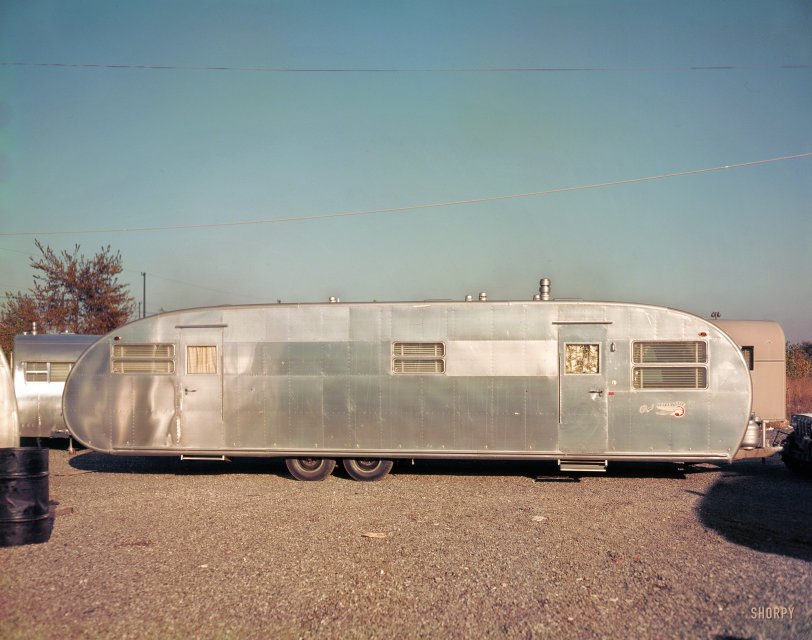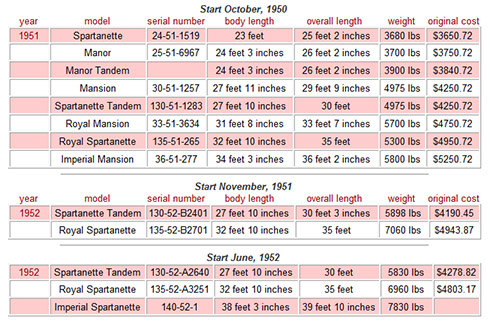


Framed or unframed, desk size to sofa size, printed by us in Arizona and Alabama since 2007. Explore now.
Shorpy is funded by you. Patreon contributors get an ad-free experience.
Learn more.

- Baldwin 62303
- Baldwin VO-1000
- Cold
- No expense spared
- Tough Guys
- Lost in Toyland
- And without gloves
- If I were a blindfolded time traveler
- Smoke Consumer Also Cooks
- Oh that stove!
- Possibly still there?
- What?!?
- $100 Reward
- Freeze Frame
- Texas Flyer wanted
- Just a Year Too Soon
- WWII -- Replacing men with women at the railroad crossing.
- Yes, Icing
- You kids drive me nuts!
- NOT An Easy Job
- I wonder
- Just add window boxes
- Icing Platform?
- Indiana Harbor Belt abides
- Freezing haze
- Corrections (for those who care)
- C&NW at Nelson
- Fallen Flags
- A dangerous job made worse
- Water Stop
Print Emporium
Royal Spartanette: 1952

Sept. 1952. "Rolling homes." Kodachrome from photos by Charlotte Brooks and Bob Lerner for the Look magazine assignment "Trailer Story." View full size.
Towing
The key issue for towing in cars of the day was not horsepower, but rather torque and the displacement of the engine. It also appears that many of these were used primarily as homes in one place, which would allow the dealer to deliver it with a one ton pickup or similar vehicle. Plus, with aluminium construction, not that heavy.
How would you pull it?
Considering most cars of that time had 90 to 120 horse power, how would you get up even a moderate grade? Seems not very practical as a 'travel trailer'.
Hold the Phone!
I spotted one just like this parked behind a business just 3 miles from my house today - what are the odds!
Got Fix-A-Flat?
Changing a flat tire must have been challenging.
Good Home For USAF Mechanics
My new wife and I spent the winter of 1957/1958 at Chanute AFB, IL as I was going through aircraft maintenance school. An enterprising Master Sergeant had parked two of these trailers in his back yard in nearby Rantoul Il and rented them to us student mechanics. Rent was $65.00 per month and it cost $1.25 to fill each of those propane tanks on the front hitch. Oil at 9 cents per gallon was used for heat.
Our total Air Force income was $150.00 per month, including my wife's allotment. There was not much money left over each month, but we were happy and have many fond memories from the experience.
It Rocks!
You can take it, say, for a vacation to Mount Whitney.
Cheap Duralumin
The source for these trailers, as well as the aluminum siding and cookware that flooded the post war market, can be seen in this video. (Warning: risque Nose Art shown):
Home Sweet Home!
I lived in a 1952 Spartan 27-foot Tandem for six months after a move to Cincinnati, the winter of 2009-10. It was parked inside a garage, fully unrestored and in reasonably okay shape. I was instructed by the owner not to do "improvements" that couldn't be undone later. It had two bunks in the back on opposite sides. A sheet of plywood could set across these to support a queen-sized mattress. The bathroom was strange: a drain in the dead center of the floor, showerhead built into the ceiling. Closing it up, everything was sprayed including the toilet. (I showered at a nearby friend's apt. instead.) Ended up moving out & up, and trailer today is sitting in another garage in mothballs. It's an odd memory of something so recent.
December 1952 "Clearance" bargains
An ad from the Bilings, MT dealer. Interesting "regular" and "sale" prices (as compared with Dave's handy spreadsheet):

Spartan Aircraft Co.
The Spartanette seems to have been a budget model, and although the name was diminutive, the trailer itself was anything but: the immense Imperial Spartanette was almost 40 feet long. (The Royal Spartanette in the photo had a body length of 32 feet 10 inches and listed for $4943 in 1952.) The senior model was called the Spartan Imperial Mansion (as noted below, something of a contradiction in terms). J. Paul Getty had something to do with the company. Click to enlarge.
Royal Spartan?
Seems a bit contradictory, like Jumbo Shrimp.
I'm pretty sure
the side of that trailer is off a Consolidated B-24.
Where Is He?!?!?
I know Ry Cooder is somewhere in the area.

























On Shorpy:
Today’s Top 5